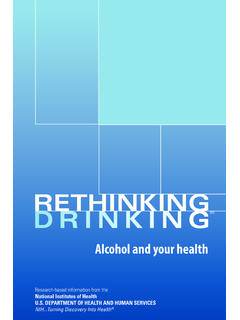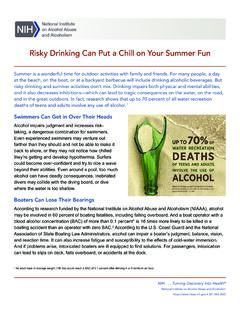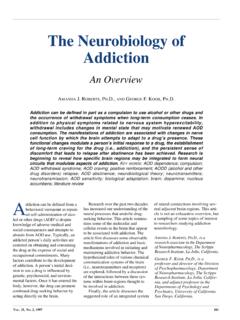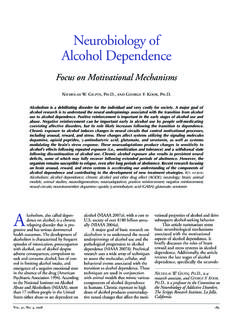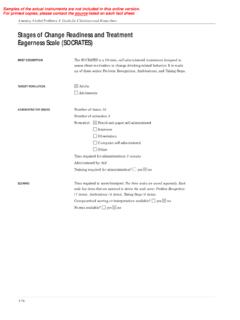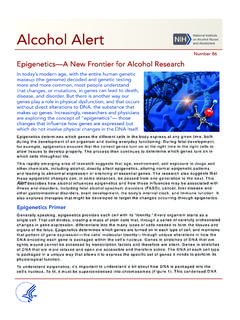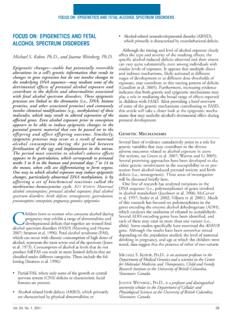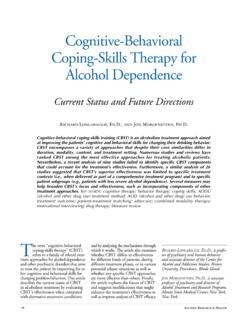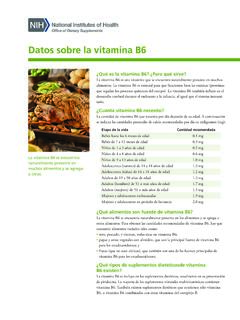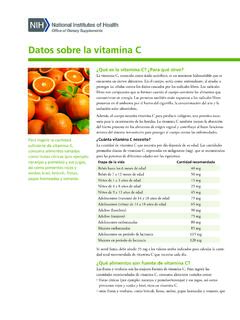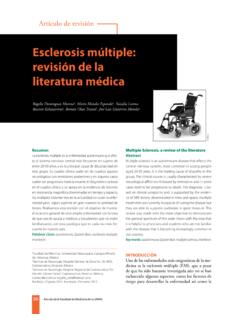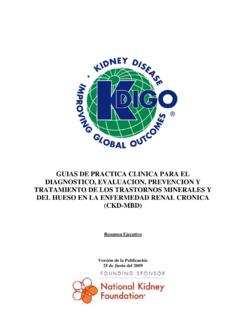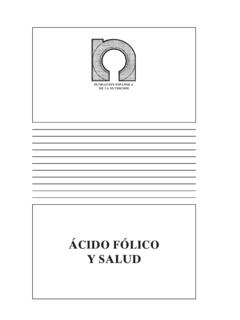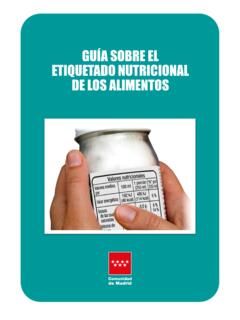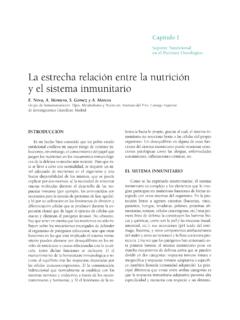Transcription of Alcohol’s Harmful Effects on Bone
1 190 Alcohol Health & Research WorldAlcohol s Harmful Effects on BoneH. Wayne Sampson, alcohol consumption can interfere with bone growth and replacement of bone tissue( , remodeling), resulting in decreased bone density and increased risk of fracture. These effectsmay be exerted directly or indirectly through the many cell types, hormones, and growth factorsthat regulate bone metabolism. Alcohol consumption during adolescence reduces peak bone massand can result in relatively weak adult bones that are more susceptible to fracture.
2 In adults, alco-hol consumption can disrupt the ongoing balance between the erosion and the remodeling ofbone tissue, contributing to alcoholic bone disease. This imbalance results in part from alcohol-induced inhibition of osteoblasts, specialized cells that deposit new bone. Some evidence suggeststhat moderate drinking may decrease the risk of fracture in postmenopausal women. KEY WORDS:chronic AODE (alcohol and other drug Effects ); bone; bone fracture; adolescent; adult; metabolism;biochemical mechanism; hormones; parathyroid; vitamin D; calcitonin; growth promoting factors;cell type; moderate AOD use; female; literature reviewBone is a living tissue that continuesto undergo change and replace-ment ( , remodeling) even aftera person has attained full stature.
3 Long-term alcohol consumption can interferewith bone growth and remodeling,resulting in decreased bone density andincreased risk of fracture. Those effectsmay be exerted directly or indirectlythrough the many cell types, hormones,and growth factors that regulate bonemetabolism. This article summarizesalcohol s Harmful Effects on bone in bothadults and adolescents. In addition, thearticle suggests possible physiologicalmechanisms that account for the devel-opment of those Harmful Structure and GrowthBone consists of living cells encasedin a hard matrix of protein fibers andcalcium crystals.
4 There are two typesof bone. Cortical bone, which isdense and thick, forms the outer layer of bones and the shafts of thelong bones of the arms and legs (seefigure 1). Cancellous bone, which is a porous meshwork of thin plates( , trabeculae), occurs mostlywithin the ends of long bones and inthe vertebrae. Alcohol affects bothtypes of bone, although the mostdramatic changes occur in cancellousbone (see figure 2, p. 192).The process of skeletal growth and maturation involves three generalphases: (1) growth and modeling, (2)consolidation, and (3) grow rapidly from birth untilthe end of puberty.
5 After bones stopgrowing lengthwise, they continue to increase in mass (referred to as consolidation) (Matkovic 1991),probably reaching peak bone mass atsome point between ages 9 and 18(Matkovic 1991). From age 16 through-out adulthood, bone undergoes con-stant remodeling and replacement inorder to maintain resilience and adaptto shifting stress patterns (Kanis 1994).Between ages 20 and 40, bone densitybegins to decline, resulting in a cumulative decrease in skeletalmass of 30 to 40 percent by age 70 (Moran et al.)
6 1995). Womenexperience an accelerated reductionin bone mineral density followingmenopause (as discussed in the H. WAYNESAMPSON, , is a professorin the Department of Human Anatomy& Medical Neurobiology, Texas A&MHealth Science Center, College ofMedicine, College Station, work was supported in part by grantAA10234 from the National Instituteon Alcohol Abuse and Reproductive Hormones, p. 192) (Kanis 1994). As aging bonesweaken, they reach a point ( , frac-ture threshold) at which even minorstress can cause BoneDevelopment and AlcoholAchieving an optimal peak bone massduring adolescence may reduce a per-son s risk for developing osteoporosis( , bone loss with fracture) later inlife.
7 A high peak bone mass shouldwithstand a longer duration and greaterlevel of bone loss before reaching thefracture threshold. Although peakbone mass appears to be largely undergenetic control (Pocock et al. 1987),it can be influenced by hormonal,nutritional, environmental, andlifestyle factors, including tobaccoand alcohol significant proportion of theadolescent population may be at risk for alcohol s Harmful Effects onbone. A nationwide survey of morethan 50,000 high school studentsfound that 63 percent of seniors had been drunk at least once and 51percent had consumed alcohol in the month before the survey.
8 Mostrespondents had consumed alcoholfor the first time before age 13 (Arriaet al. 1991).Results of experiments using laboratory animals suggest potentialconsequences of alcohol consump-tion during adolescent bone alcohol administration to young, rapidly growing rats signifi-cantly reduced bone growth, volume,density, and strength (Hogan et ; Sampson et al. 1996, 1997).The longitudinal growth rate and the rate of proliferation of cells in the growing region near the ends of long bones ( , growth plates)stop during long-term alcoholadministration.
9 If those Effects occurin humans, they could significantlydecrease bone mass. The decreasedbone mass that occurs from early,long-term alcohol consumptioncould result in increased fracture andearly onset of s Effects on Hormones thatRegulate BoneIn addition to providing structuralsupport, bone is a major storagedepot for calcium and other small intestine absorbs calciumfrom ingested food, and the kidneysexcrete excess calcium. An adequateconcentration of calcium in thebloodstream is required for theproper functioning of nerves andmuscle.
10 The body monitors calciumconcentration and responds throughthe action of hormones, vitamins,and local growth factors to regulatethe distribution of calcium betweenblood and bone. Alcohol maydisrupt this balance by affecting the hormones that regulate calciummetabolism as well as the hormonesthat influence calcium metabolismindirectly ( , steroid reproductivehormones and growth hormone[GH]) (Sampson 1997).Calcium-Regulating HormonesParathyroid Hormone. Parathyroidhormone (PTH) is secreted into thebloodstream by four small glands locatedbehind the thyroid gland in the hormone, which is produced inresponse to decreasing levels of calciumin the blood, stimulates the activity ofspecialized bone cells called osteoclasts(see figure 3, p.)
